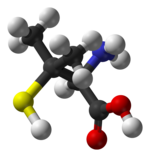페니실라민
Penicillamine | |
 | |
| 임상자료 | |
|---|---|
| 상명 | 큐프리민, 큐프레닐, 데펜 등 |
| 기타 이름 | D페니실라민 |
| AHFS/Drugs.com | 모노그래프 |
| 메드라인플러스 | a618021 |
| 라이센스 데이터 | |
| 임신 범주 |
|
| 경로: 행정 | 입으로(캡슐) |
| ATC 코드 | |
| 법적현황 | |
| 법적현황 |
|
| 약동학 데이터 | |
| 생체이용가능성 | 변수 |
| 신진대사 | 간 |
| 제거 반감기 | 1시간 |
| 배설 | 신장 |
| 식별자 | |
| |
| CAS 번호 | |
| 펍켐 CID | |
| IUPHAR/BPS | |
| 드러그뱅크 | |
| 켐스파이더 | |
| 유니 | |
| 케그 | |
| 체비 | |
| 켐벨 | |
| CompTox 대시보드 (EPA) | |
| ECHA InfoCard | 100.000.136 |
| 화학 및 물리적 데이터 | |
| 공식 | C5H11NO2S |
| 어금질량 | 149.21 g·18−1 |
| 3D 모델(JSmol) | |
| |
| |
| (iii) | |
그중에서도 큐프리민이라는 상표명으로 판매되는 페니실라민은 윌슨병 치료에 주로 쓰이는 약이다.[1]소변 낭종 수치가 높고 류마티스성 관절염, 각종 중금속 독이 있는 신장결석을 가진 사람에게도 쓰인다.[1][2]그것은 입으로 가져간다.[2]
의학적 용법
페니실라민은 1970년 미국에서 의료용으로 승인되었다.[1]그것은 세계보건기구의 필수 의약품 목록에 올라 있다.[3]
그것은 킬레이트 제제로 사용된다.
- 구리의 신진대사의 희귀 유전질환인 윌슨병에서 페니실라민 치료는 구리의 축적과 소변을 통한 제거에 결합에 의존한다.[4]
- 페니실라민은 디메르카프롤(BAL)에 이어 두 번째 비소 중독 치료제였다.[5]그것은 더 이상 추천되지 않는다.[6]
소변시스틴이 높은 유전성 질환인 낭설증에서는 페니실라민이 시스틴과 결합해 시스틴보다 용해성이 높은 혼합 이황화물을 산출한다.[7]
페니실라민은 스크레로더마를 치료하는데 사용되어 왔다.[8]
페니실라민은 TNF 억제제 및 Tocilizumab, facitinib 등 다른 제제의 이용가능성 때문에 오늘날에는 거의 사용되지 않으나,[9] 재래요법의 적절한 실험에 응하지 않은 환자에게는 중증 활성 류마티스성 관절염을 치료하는 질환 변형 항류마티스제(DMARD)로 사용될 수 있다.페니실라민은 T-림프모세포의 수를 줄이고 대식세포 기능을 억제하며 IL-1을 감소시키고 류마티스 인자를 감소시키며 콜라겐이 교차연결을 방지하는 작용을 한다.
역효과
흔한 부작용으로는 발진, 식욕 상실, 메스꺼움, 설사, 저혈구 백혈구 수치가 있다.[1]다른 심각한 부작용으로는 간 질환, 말기 기관지염, 마이스테니아 그라비스가 있다.[1]그것은 루푸스 에리테마토스를 가진 사람들에게는 권장되지 않는다.[2]임신 중에 사용하면 아기에게 해를 끼칠 수 있다.[2]페니실라민은 중금속을 결합하여 작용한다. 그 결과 페니실라민-메탈 복합체는 소변에서 몸에서 제거된다.[1]
골수 억제, 이질, 거식증, 구토, 설사 등이 가장 흔한 부작용이며, 페니실라민으로 치료된 환자의 약 20~30%에서 발생한다.[10][11]
기타 가능한 부작용은 다음과 같다.
- 신혈증[7][10]
- 간독성[12]
- 막구상구균염[13]
- 재생불량성빈혈(이상성 빈혈)[12]
- 항체 매개 마이스테니아 그라비스와[10] 램버트-에톤 마이스테닉 증후군, 탈퇴 후에도 지속될 수 있음
- 약물에 의한 전신 루푸스 에리테마토스[14]
- 탄수화 천공 세르피기노사[15]
- 독성 근병증[16]
- 원치 않는 유방 성장[17]
- 과두증
화학
페니실라민은 3기능성 유기 화합물로 티올, 아민, 카르복실산으로 구성된다.구조적으로는 α-아미노산 시스테인과 비슷하지만 티올에는 보석 디메틸 대체물 α가 들어 있다.대부분의 아미노산과 마찬가지로 생리적 pH에서 zwitterionic 형태로 존재하는 무색 고체다.
페니실라민은 스테레오제 중앙이 1개 있는 치랄 약물로, 에나토머 한 쌍으로 존재한다.페니실라민 에나토머의 구조는 이미지를 참조하십시오.에우토머인 에우토머는 반관절염인 반면 디스토머(R) 페니실라민은 매우 독성이 강하다.[18]두 개의 항산화제 중 L-페니실라민(Having R 절대구성)은 피리독신(비타민B라고도6 함)의 작용을 억제하기 때문에 독성이 있다.[19]그 에반토머는 페니실린의 대사물이지만 항생물질 자체는 없다.[20]다양한 페니실라민-코퍼 복합 구조가 알려져 있다.[21]
역사
존 월쉬는 1956년 윌슨병에서 페니실라민의 사용을 처음 묘사했다.[22]그는 페니실린을 복용한 환자(자신을 포함)의 소변에서 이 화합물을 발견했고, 실험적으로 킬레이트화에 의해 비뇨동 배설량이 증가한 것을 확인했다.그는 초기에 윌슨의 병은 주로 구리 항진증의 문제가 아니라 아미노산 대사의 문제이며 디메르카프롤을 첼레이터로 사용해야 한다고 주장했기 때문에 여러 세계 전문가들(데니 브라운과 커밍스)에게 그 효능을 설득하는 데 어려움을 겪었다.이후의 연구는 구리 중심 이론과 D-페니실라민의 효능을 모두 확인했다.월쉬는 또한 트리에틸렌 테트라민, 테트라티오몰리브데이트와 같은 윌슨의 다른 첼로이터들을 개척했다.[23]
페니실라민은 로버트 로빈슨 감독 하에 존 콘포스에 의해 처음 합성되었다.[24]
페니실라민은 1964년 첫 성공사례 이후 류마티스 관절염에 사용되어 왔다.[25]
비용
미국에서 발레앙트는 2016년 약 500달러였던 약값을 월 24,000달러로 인상했다.[26]
참조
- ^ a b c d e f "Penicillamine". The American Society of Health-System Pharmacists. Archived from the original on 21 December 2016. Retrieved 8 December 2016.
- ^ a b c d World Health Organization (2009). Stuart MC, Kouimtzi M, Hill SR (eds.). WHO Model Formulary 2008. pp. 64, 592. hdl:10665/44053. ISBN 9789241547659.
- ^ World Health Organization (2019). World Health Organization model list of essential medicines: 21st list 2019. Geneva. hdl:10665/325771. WHO/MVP/EMP/IAU/2019.06. License: CC BY-NC-SA 3.0 IGO.
- ^ Peisach, J.; Blumberg, W. E. (1969). "A mechanism for the action of penicillamine in the treatment of Wilson's disease". Molecular Pharmacology. 5 (2): 200–209. PMID 4306792.
- ^ Peterson, R. G.; Rumack, B. H. (1977). "D-Penicillamine therapy of acute arsenic poisoning". The Journal of Pediatrics. 91 (4): 661–666. doi:10.1016/S0022-3476(77)80528-3. PMID 908992.
- ^ Hall, A. H. (2002). "Chronic arsenic poisoning". Toxicology Letters. 128 (1–3): 69–72. doi:10.1016/S0378-4274(01)00534-3. PMID 11869818.
- ^ a b Rosenberg, L. E.; Hayslett, J. P. (1967). "Nephrotoxic Effects of Penicillamine in Cystinuria". JAMA: The Journal of the American Medical Association. 201 (9): 698–9. doi:10.1001/jama.1967.03130090062021. PMID 6071831.
- ^ Steen, V. D.; Medsger Jr, T. A.; Rodnan, G. P. (1982). "D-Penicillamine therapy in progressive systemic sclerosis (scleroderma): A retrospective analysis". Annals of Internal Medicine. 97 (5): 652–659. doi:10.7326/0003-4819-97-5-652. PMID 7137731.
- ^ "Cuprimine (penicillamine) Capsules for Oral Use. U.S. Full Prescribing Information" (PDF). Archived (PDF) from the original on 8 September 2015. Retrieved 29 April 2016.
- ^ a b c Camp, A. V. (1977). "Penicillamine in the treatment of rheumatoid arthritis". Proceedings of the Royal Society of Medicine. 70 (2): 67–69. doi:10.1177/003591577707000201. PMC 1542978. PMID 859814.
- ^ Grasedyck, K. (1988). "D-Penicillamine—side effects, pathogenesis and decreasing the risks". Zeitschrift für Rheumatologie. 47 Suppl 1: 17–19. PMID 3063003.
- ^ a b Fishel, B.; Tishler, M.; Caspi, D.; Yaron, M. (1989). "Fatal aplastic anaemia and liver toxicity caused by D-penicillamine treatment of rheumatoid arthritis". Annals of the Rheumatic Diseases. 48 (7): 609–610. doi:10.1136/ard.48.7.609. PMC 1003826. PMID 2774703.
- ^ Mitchell, Richard Sheppard; Kumar, Vinay; Abbas, Abul K.; Fausto, Nelson (2007). "Table 14-2". Robbins Basic Pathology (8th ed.). Philadelphia: Saunders. ISBN 978-1-4160-2973-1.
- ^ Chalmers, A.; Thompson, D.; Stein, H. E.; Reid, G.; Patterson, A. C. (1982). "Systemic lupus erythematosus during penicillamine therapy for rheumatoid arthritis". Annals of Internal Medicine. 97 (5): 659–663. doi:10.7326/0003-4819-97-5-659. PMID 6958210.
- ^ Bolognia, Jean; et al. (2007). Dermatology. Philadelphia: Elsevier. ISBN 978-1-4160-2999-1.제2판
- ^ Underwood, J. C. E. (2009). General and Systemic Pathology. Elsevier Limited. ISBN 978-0-443-06889-8.
- ^ Taylor; Cumming; Corenblum (31 January 1981). "Successful treatment of D-penicillamine-induced breast gigantism with danazol". Br Med J. 282 (6261): 362–3. doi:10.1136/bmj.282.6261.362-a. PMC 1504185. PMID 6780026.
- ^ Ariens, E.J (1989). Chiral Separations by HPLC. Chichester: Ellis Horwwod, Chichester. pp. 31–68.
- ^ Aronson, J. K. (2010). Meyler's Side Effects of Analgesics and Anti-inflammatory Drugs. Amsterdam: Elsevier Science. p. 613. ISBN 9780080932941. Archived from the original on 10 September 2017.
- ^ Parker, C. W.; Shapiro, J.; Kern, M.; Eisen, H. N. (1962). "Hypersensitivity to penicillenic acid derivatives in human beings with penicillin allergy". The Journal of Experimental Medicine. 115 (4): 821–838. doi:10.1084/jem.115.4.821. PMC 2137514. PMID 14483916.
- ^ Birker, Paul J. M. W. L.; Freeman, Hans C. (1977). "Structure, properties, and function of a copper(I)–copper(II) complex of D-penicillamine: pentathallium(I) μ8-chloro-dodeca(D-penicillaminato)octacuprate(I)hexacuprate(II) n-hydrate". J. Am. Chem. Soc. 99 (21): 6890–6899. doi:10.1021/ja00463a019. PMID 903530.
- ^ Walshe, J. M. (January 1956). "Wilson's disease; new oral therapy". Lancet. 270 (6906): 25–6. doi:10.1016/S0140-6736(56)91859-1. PMID 13279157.
- ^ Walshe, J. M. (August 2003). "The Story of Penicillamine: a Difficult Birth". Mov. Disord. 18 (8): 853–9. doi:10.1002/mds.10458. PMID 12889074. S2CID 11406561.
- ^ Oakes, Elizabeth H. (2007). Encyclopedia of World Scientists. Infobase Publishing. p. 156. ISBN 9781438118826.
- ^ Jaffe, I. A. (1964). "Rheumatoid Arthritis with Arteritis; Report of a Case Treated with Penicillamine". Annals of Internal Medicine. 61: 556–563. doi:10.7326/0003-4819-61-3-556. PMID 14218939.
- ^ Petersen, Melody. "How 4 drug companies rapidly raised prices on life-saving drugs". Los Angeles Times. Retrieved 27 March 2019.
외부 링크
- "Penicillamine". Drug Information Portal. U.S. National Library of Medicine.



